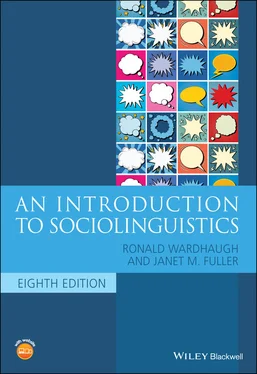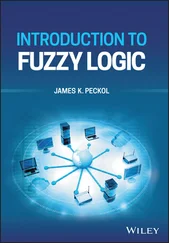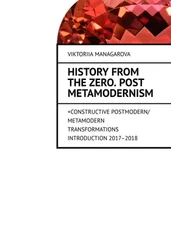(5) There are multiple forces that play a role in the construction of identities. Much of our identity performance is unconscious, although we may also think about our performances or even practice them in front of the bathroom mirror! Further, in some cases, identity categorizations may be imposed upon individuals by others (Kroskrity 2000, 113) or they may be severely constrained by others’ perceptions (Bucholtz and Hall 2005). For instance, Fuller (2012) reports about a girl in a German‐English bilingual classroom in Berlin, Germany, who repeatedly attempted to establish her identity as a speaker of German by using this code with her classmates. However, by often replying to her in English, her peers constrained her construction of her bilingual identity.
The concept of identity we provide here is probably a very different meaning from how you might use this word in your everyday life; in sociolinguistics, and in social theory more generally, this term has a very specific meaning. So for the purpose of doing sociolinguistics, you will need to think of identity as something which is continually reconstructed and may be redefined through discourse; identities do not exist outside of discourse (see Baxter 2002, drawing on the work of Foucault 1980).
Issues of identity are particularly salient in work by Rampton (1995a, 1995b, 1999, 2001, 2010) on what he calls crossing: ‘Language crossing involves code alternation by people who are not accepted members of the group associated with the second language that they are using (code switching into varieties that are not generally thought to belong to them)’ (Rampton 1995a, 485). The participants in his research are London teenagers, some of whom come from families who came to England from Pakistan or Jamaica, and speak Panjabi or Jamaican Creole in addition to various varieties of English, for example, Asian English, working‐class London English dialects, and Standard English varieties. Within multiethnic social networks the teens use all these codes in various ways to index various stances and identities. While these youths have their own speech community, they also participate in other communities which lay claim to them, particularly ethnic communities. They integrate repertoires and adopt (and mock) norms of speaking from these other communities in their youth networks.
Each individual is therefore a member of many different groups. It is in the best interests of most people to be able to identify themselves on one occasion as members of one group and on another as members of another group. Such groups also may or may not overlap. One of the consequences of the intersecting identifications is, of course, linguistic variation: all people do not speak alike, nor does any individual always speak in the same way on every occasion. The variation we see in language must partly reflect a need that people have to be seen as the same as certain other people on some occasions and as different from them on other occasions.
How identities are constructed and manifested is a pervasive issue in sociolinguistics. We will see its relevance to language use in the chapters that follow. In chapters 5– 7, we will address how the concept of identity is approached through different sociolinguistic methodologies. Chapter 8will show how the study of identities is addressed in this study of multilingualism, and chapter 11will include a discussion of research on gender and sexuality identities.
Beliefs about Language and Social Groups
A key aspect of the study of language and social groups is that how languages are evaluated usually has very little to do with their linguistic features, and much more to do with the social status of the groups associated with them. These beliefs about linguistic groups also influence how language users use particular features and varieties of languages and are thus central to our understandings of social groups and language use.
Many people hold strong beliefs on various issues having to do with language and are quite willing to offer their judgments on these issues (see Bauer and Trudgill 1998; Niedzielski and Preston 1999). They believe such things as certain languages lack grammar, that you can speak English without an accent, that French is more logical than English, that parents teach their children to speak, that primitive languages exist, that English is degenerating and language standards are slipping, that pronunciation should be based on spelling, and so on and so on. Much discussion of language matters in the media concerns such ‘issues’ and there are periodic attempts to ‘clean up’ various bits and pieces, attempts that Cameron (1995) calls ‘verbal hygiene.’ Unfortunately, often people who voice opinions on this do not have any background in linguistics, but it has proven difficult to educate them otherwise. (But we hope that, after reading this book, you will go on to try.)
While sociolinguistic research on language largely focuses on a descriptive, not prescriptive, approach, attitudes and ideologies about language influence language use, as well as being areas of study in their own right. In the next two sections, we will look at two strands of research that address how such lay beliefs about language and social groups are an important part of the study of sociolinguistics.
Sociolinguists have increasingly been aware that how people feel about different ways of speaking, and how they evaluate particular linguistic features, plays a role in how they use language. Here we will review research on language ideologies, and in the next section we will discuss research on language attitudes. These two areas of study are generally distinguished in two ways: language attitude research looks at the ideas about specific varieties held by people from different sociolinguistic groups, while language ideology research looks at societal discourses and how they are reproduced in media as well as public and private speech. Language attitudes and ideologies clearly interact and influence each other, and the lines between them may become blurred. However, there are also methodological differences, with language ideology research focusing more exclusively on discourse analytic methods and traditional language attitude research employing methods which seek to elicit speakers’ views, often via surveys.
Errington (2000, 115) describes the study of language ideologies as ‘a rubric for dealing with ideas about language structure and use relative to social contexts.’ Particularly relevant here are ideologies which privilege certain ways of speaking as inherently ‘better’ than others. While there are many language ideologies (see Fuller 2019 for an overview), here we will introduce three commonly occurring language ideologies: the standard language ideology, the purist ideology, and the monoglot ideology.
The standard language ideology
The standard language ideology revolves around the belief that a particular variety of a given language (the standardized variety) is superior to other related varieties (which are often labeled as ‘dialects,’ as discussed in chapter 2). Inherent in this ideology is the belief that languages are internally homogeneous, bounded systems. The concept of hegemonyis important here; hegemonic ideologies are dominant ideologies which achieve their dominance in society through broad consensus and acceptance of them as some sort of ‘truth.’ Although as linguists we know that there is nothing linguistically superior about the standard, belief in its superiority is so widespread that many people will come up with arguments about why certain nonstandard features of language are linguistically inferior (i.e., ‘lazy’ or ‘illogical’). Here, even those who are disadvantaged by these ideologies believe in them – thus it is not uncommon for speakers of nonstandard varieties to consider their own language deficient because they have accepted the standardized language ideology as ‘truth.’ Lippi‐Green (2012) exemplifies and refutes the standard language ideology in a chapter titled ‘The Real Trouble with Black English,’ saying that although criticisms of AAVE are often made on the basis of linguistic inferiority, linguistic analyses have shown that AAVE is a rule‐governed, systematic language with every bit as much sophistication as any other variety of English. What bothers speakers of Standard English is that they feel that continued use of AAVE is a rejection of mainstream – often perceived as White – middle‐class values.
Читать дальше




![Andrew Radford - Linguistics An Introduction [Second Edition]](/books/397851/andrew-radford-linguistics-an-introduction-second-thumb.webp)







